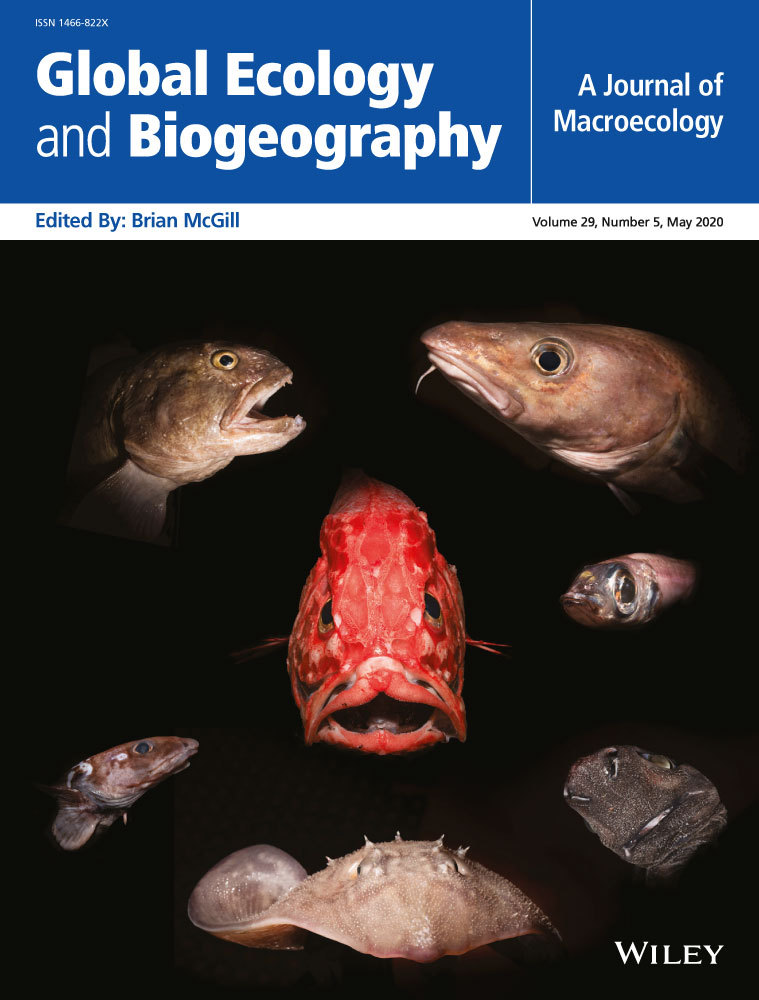Morphological sorting of introduced freshwater fish species within and between donor realms
Abstract
Aim
To determine which morphological characteristics make a fish species a good candidate for introduction and establishment, we tested whether (a) introduced species differ in morphology from non-introduced species (species only existing in native areas and not introduced to new areas) in each donor assemblage (biogeographic realm fauna); (b) within the introduced species, the morphology of established species (self-sustaining introduced species) differs from that of the non-established species; (c) within the established species, those exported out of their native realm have more extreme morphological traits than those translocated within their native realm.
Major taxa studied
Freshwater fish.
Location
Global.
Time period
1960s–2010s.
Methods
We used a global database of freshwater fishes from the six realms. Ten morphological traits were measured on 9,150 species. Principal component analysis was conducted to combine the 10 traits into a multidimensional morphospace. We used permutational multivariate analysis of variance (PERMANOVA) and permutational analysis for the multivariate homogeneity of dispersions (PERMDISP2) to compare the distribution of species groups in the morphospace and Kolmogorov–Smirnov tests to compare their distributions on principal component (PC) axes.
Results
The morphology of introduced species differed from that of non-introduced species in all the six biogeographic realms. Among introduced species, established species had more extreme morphological traits than non-established species in most realms. Among established species, exported species had more extreme morphological traits than translocated species.
Main conclusions
Morphological differences between introduced and non-introduced species was driven by an anthropogenic trait selection for fisheries and angling, leading to the preference for the introduction of predators with large and laterally compressed bodies. Established species represent a small subset of introduced species morphologies, with established species having more extreme morphological traits than their non-established counterparts. Established fish have morphologies more adapted to lentic waters, and this trend was more marked for species exported to other realms than for species translocated within their native realm.
1 INTRODUCTION
Species invasion is one of the main drivers of the human-induced biodiversity crisis (Clavero & García-Berthou, 2005; Leprieur, Beauchard, Blanchet, Oberdorff, & Brosse, 2008; Vitousek, D’antonio, Loope, Rejmanek, & Westbrooks, 1997). Biological invasions have altered patterns of biodiversity from local to continental scales and resulted in both ecological and economic impacts on entire ecosystems (Simberloff et al., 2013; Vitule, Freire, & Simberloff, 2009). Those detrimental impacts are at least in part due to the ecological differences between native species and introduced species that have become established in the recipient ecosystems. Introduced species establishing in new environments are most often larger than the species from the recipient faunas (Blackburn, Cassey, & Lockwood, 2009; Blanchet et al., 2010; Roy, Jablonski, & Valentine, 2002) and perform functions distinct from those existing in recipient faunas (Marchetti, Moyle, & Levine, 2004; Toussaint et al., 2018). For instance, Olden, Poff, and Bestgen (2006) showed that introduced fishes that established in the Colorado River (USA) occupy vacant niches and have different life-history strategies compared with those of the native species. Similarly, Blackburn et al. (2009) demonstrated that the establishment success of exotic birds increases with a particular combination of ecological traits.
Since human population and economic exchanges are identified as the key drivers of species introduction and establishment in new environments (Leprieur et al., 2008; Pyšek et al., 2010), global human population growth and accelerated economic development are predicted to increase the number of candidate species for introduction as well as their establishment success (Hulme, 2009; Seebens et al., 2017, 2018). This is particularly true in freshwater ecosystems, which are among the most highly invaded ones (Moyle & Marchetti, 2006), especially because several hundreds of fish species have been transported by humans outside their native range for the three last centuries (Leprieur et al., 2008; Toussaint et al., 2018).
Fish morphology has been suggested to be related to species establishment success in both marine and freshwater ecosystems (Azzurro et al., 2014; Blanchet et al., 2010; Ribeiro, Elvira, Collares-Pereira, & Moyle, 2008). Up to now, it has been reported that established freshwater fish species (i.e. introduced species that successfully established in the new habitat) morphologically and functionally differ from the recipient fauna (e.g. Blanchet et al., 2010; Marchetti et al., 2004; Olden et al., 2006; Toussaint et al., 2018). Established species tend to be larger, with deeper bodies, and to have more piscivorous or detritivorous diets (Cucherousset, Blanchet, & Olden, 2012; Toussaint et al., 2018). However, functional diversity of fishes markedly varies between the six biogeographic realms, namely the Afrotropical, Australian, Neotropical, Nearctic, Oriental and Palaearctic realms (Su, Villéger, & Brosse, 2019; Toussaint, Charpin, Brosse, & Villéger, 2016). Therefore, to work towards a better understanding of the causes and consequences of the invasion process in the world’s rivers, it is important to disentangle the relative importance of the natural functional differences between donor zones, the human preference for some functional characteristics and the capacity of each introduced species to establish (or not) in a new environment.
Tackling this challenge requires sequential consideration of the introduction and establishment steps of the species invasion process, as proposed by Blackburn et al. (2011) and Lockwood, Hoopes, and Marchetti (2013), within each realm. We therefore distinguished between non-introduced species, which only exist in native areas and have never been introduced to new areas, and introduced species, which have at least once been introduced into areas (here river basins) where they did not historically occur (Figure 1a). We here tested the hypothesis that within each realm, humans select particular morphologies for the species to be introduced (Figure 1b). Once introduced, a species can establish or not in its new environment (Figure 1a). The success of establishment is largely influenced by the match between physical (climate, habitat) and biological (competitors, predators and prey) environment and the capacities of the introduced species (Lockwood et al., 2013). A morphological difference between established and non-established species (Figure 1c) would therefore indicate trait-based filtering affecting the establishment success of introduced species (Moyle & Marchetti, 2006). Moreover, translocated fishes that were introduced to nearby areas from their native range (i.e. within same realm) are more prone to adapt to local abiotic conditions and biotic interactions than species exported to other realms, potentially facing markedly different conditions in those distant areas (Ribeiro et al., 2008). Thus, if physical and biological characteristics of the recipient environment differ between realms, we predict that the functional characteristics of the exported species will differ from those of the translocated species, exported species being therefore more morphologically extreme than translocated species (Figure 1d). We applied this framework to the world’s freshwater fish faunas, considering more than 14,000 species from the 6 biogeographic realms.
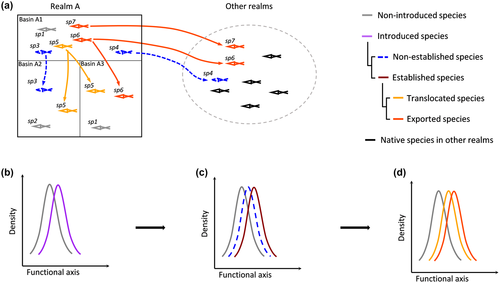
2 MATERIALS AND METHODS
Fish occurrence was compiled from Tedesco et al. (2017), which gives the occurrence of 14,953 species (more than 90% of the freshwater fish species) in 3,119 drainage basins, covering more than 80% of the Earth’s surface. Each occurrence is paired with a status, either native or non-native established if the species was not historically present in the drainage river basin. As more than 98% of the species historically belong to a single realm (Tedesco et al., 2017), we used these data to determine for each realm the list of native species that have been introduced and then established within their native realm (translocated species) or in at least another realm (exported species).
Distinguishing between introduced and non-introduced species cannot be done easily because there is no global database or realm scale record of introduction attempts (only successful introductions, that is, established species, are recorded). Nevertheless, introductions of vertebrates are mainly via intentional pathways to achieve various human purposes, including farming, for ornaments, and gaming (Saul et al., 2017). This also holds for fishes and many studies have reported that freshwater fish introductions are driven by human interest (e.g. aquaculture, pest control, game fishing). Most freshwater fish species introductions are therefore intentional or at least human assisted (e.g. Gozlan, Britton, Cowx, & Copp, 2010; Leprieur et al., 2008; Marchetti et al., 2004; Padilla & Williams, 2004). We thus collected the list of species of interest to humans from FishBase (Froese & Pauly, 2018) and Blanchet et al. (2010), and these species were considered as those having a high chance of having been introduced in at least one river outside their native range (hereafter called introduced species). Within those introduced species, we then distinguished between non-established and established species using non-native occurrences from Tedesco et al. (2017). Since established species are considered as self-sustaining populations, populations of non-native species artificially maintained by constant release [e.g. rainbow trout (Oncorhynchus mykiss) in many European river basins, Stanković, Crivelli, & Snoj, 2015] were not considered as established (Tedesco et al., 2017).
Among the 14,953 species present in the occurrence database, 9,150 species were morphologically described using pictures and drawings from textbooks and scientific websites (Su et al., 2019). More precisely, morphology was assessed using 10 traits describing the size and shape of body parts involved in food acquisition and locomotion (Toussaint et al., 2016; Villéger, Brosse, Mouchet, Mouillot, & Vanni, 2017). The 10 traits were selected to be complementary, and they were indeed not markedly correlated to each other (Spearman test, rho < .45 for all the 45 trait comparisons). More precisely, the fish size was described using the maximum body length (Max. Body Length) taken from FishBase (Froese & Pauly, 2018). These maximum body lengths were carefully reviewed, and irrelevant measures were corrected according to the appropriate literature. In addition to size, 11 morphological measures were assessed on side view pictures (Supporting Information Figure S1a) collected during an extensive literature review including our own field data and scientific literature sources made up of peer-reviewed articles, books, and scientific websites. We collected at least one picture (photograph or scientific drawing) per species. Only good quality pictures and scientific side view drawings of entire adult animals with confirmed species identification were kept. For species with marked sexual dimorphism, we considered male morphology, as female pictures are scarce for most species (especially for Perciformes and Cyprinodontiformes). Intraspecific morphological trait variability was not considered in this study as it hardly affects functional diversity at the large spatial resolution considered (Toussaint et al., 2018). The nine unitless traits describing the morphology of the fish head (including mouth and eye), body, pectoral and caudal fins (Supporting Information Figure S1b) were computed as ratios between 11 morphological measures using ImageJ software (http://rsb.info.nih.gov/ij/index.html). The 10 morphological traits (nine unitless ratios and body size) selected are commonly used in assessment of fish functional diversity (e.g. Bellwood, Goatley, Brandl, & Bellwood, 2014; Su et al., 2019; Toussaint et al., 2016; Villéger, Miranda, Hernandez, & Mouillot, 2010) and are linked to the feeding and locomotion functions of fish that determine their contribution to key ecosystem processes, such as controlling food webs and nutrient cycles (Villéger et al., 2017) (Supporting Information Figure S1b). Functional traits not measurable on side pictures, such as gut length, oral gape area and shape, were not included because they are currently only available for a few species in public databases. Some species have unusual morphologies (species without tails, flatfishes) that prevent the measurement of some morphological traits. We thus applied conventions as mentioned in Su et al. (2019); Toussaint et al. (2016); Villéger et al. (2010) for these few exceptions.
2.1 Statistical analyses
Due to the lesion of body parts or the quality of fish pictures, some traits were not measured for some species. Overall, 17.3% of the values were missing in the raw morphological traits dataset (from 6.8% for maximum body length to 24.5% for relative maxillary length). These missing values (NA) were replaced by estimates provided by a random forest algorithm called ‘missForest’ (Penone et al., 2014; Stekhoven & Bühlmann, 2012). This method uses a random forest trained on the observed values of a data matrix to predict the missing values and automatically calibrates the filling values by a set of iterations (Stekhoven & Bühlmann, 2012). It can be used to impute continuous and/or categorical data and is not biased by complex interactions or nonlinear relationships (Stekhoven & Bühlmann, 2012). The efficiency of the random forest model used to fill missing values was tested on a random set of 1,000 species with complete values for all 10 traits. We randomly set 20% of the values for the 1,000 species as NA, and then used the ‘missForest’ to fill the NA with simulated values. We then compared the simulated values to the actual values. This procedure was repeated 999 times. Spearman’s rho between actual and simulated data was used to measure the efficiency of the procedure. Spearman’s rho varied from .89 to .96, testifying for the efficiency of the method. As a comparison, we also tried to fill the NA by the average value of the trait for closely related species (genera). In this case, the Spearman’s rho varies from .83 to .91, which means that the ‘missForest’ procedure outperforms the classical imputation method of filling the gaps using the average trait value of closely related species.
We then computed a principal component analysis (PCA) using values of the 10 morphological traits for all the species (Maire, Grenouillet, Brosse, & Villéger, 2015). We used a sensitivity procedure to assess the robustness of our selected morphological traits. We tested the effect of trait identity on the distance between species (i.e. Euclidean distance in the 5D space) by rerunning the PCA based on all combinations of nine morphological traits out of ten. The distance between species was hardly affected by morphological traits accounted for (Mantel tests, r > .900, p < .001).
PERMANOVA and PERMDISP2 tests were conducted to compare the average and variance distributions of non-introduced, introduced, non-established, established, translocated and exported species in the morphological space in each realm and in the world. We then illustrated the distributions of these groups on the first five PC axes using transformed raincloud plots (Allen, Poggiali, Whitaker, Marshall, & Kievit, 2018), and compared distributions between groups using Kolmogorov–Smirnov tests (hereafter K-S tests).
All statistical analyses were performed with the R software environment version 3.3 (R Core Team, 2018). We used ‘missForest’ from the ‘missForest’ R package (Stekhoven & Bühlmann, 2012) to fill the missing trait values, the ‘adonis’ and ‘betadisper’ functions from the ‘vegan’ R package (Oksanen et al., 2010) to conduct the PERMANOVA and PERMDISP2 tests (Euclidean distance, permutations = 9,999), and the ‘ks.test’ function from the ‘stats’ R package (R Core Team, 2018) to conduct the K-S tests.
3 RESULTS
Among the 9,150 studied species, 2,690 species have been introduced while only 418 species (including 311 translocated species and 107 exported species) successfully established in the recipient assemblages. The remaining 2,272 introduced species failed to establish. Most of the non-established species originate from the Afrotropical (877), Neotropical (651) and Oriental (475) realms. In contrast, most of the established species (translocated and exported species) originate from the Nearctic and Palaearctic realms (129 and 105 translocated species in Nearctic and Palaearctic realms, respectively, 34 and 39 exported species in Nearctic and Palaearctic realms, respectively). The Australian realm hosts the least translocated species (18) and exported species (1) (Supporting Information Table S1). Exported species from the Australian realm were therefore not considered in the K-S test.
The first five PC axes explained 78.6% of the total variance among the world’s fish morphologies (Supporting Information Figure S2). No axis was driven by a single trait and all traits contributed to the position of species in the functional space (Supporting Information Figure S2). The PC1 axis shows a strong contribution of fish mouth size and position and therefore codes for trophic level, with higher trophic levels (predators) having positive values on this axis. The PC2 axis shows a strong contribution of fish eye vertical position and body lateral shape and therefore codes for fish position in the water column, with benthic species having positive values on this axis. The PC3 axis shows a strong contribution of body elongation and fin size. It therefore codes for habitat type and locomotion, with higher dispersal ability in slow-flowing habitats having positive values on this axis. PC4 is also strongly influenced by body elongation but also by fish body size, with large and laterally flattened fish represented by positive values. The PC5 axis shows a strong contribution of caudal peduncle throttling and therefore codes for locomotion, fish with higher dispersal ability having positive values on this axis (Supporting Information Figure S2). Overall, PC1, PC2 and PC4 accounted for both nutrition and locomotion, whereas PC3 and PC5 were mainly influenced by traits related to locomotion.
Introduced species occupied 58.22% of the global species pool in the 5D morphospace, which is higher than the space occupied by non-introduced species (45.02%), although the number of introduced species is less than half that of the non-introduced species. Intriguingly, within the introduced species, the morphospace occupied by non-established species (56.58%) was almost the same as the space occupied by the introduced species, but the established species occupied only 7.15% of the global morphospace, which accounted for 1/8 of the morphospace occupied by non-established species (Figure 2). A similar pattern was observed in all the six realms, in which the space occupied by introduced species was higher than the space occupied by the non-introduced species. This pattern was more pronounced in the two arctic realms. For instance, in the Nearctic realm, introduced species represent 40% of the species but more than 65% of the morphological space of the realm. The space occupied by non-established species varied from 38.56 to 44.18%, whereas the space occupied by established species varied from 0.22 to 5.08% (Figure 3). As subgroups of established species, translocated and exported species also occupied small portions of the morphospace filled by all the species from the globe (Figure 2), and from their respective realms (Figure 3).
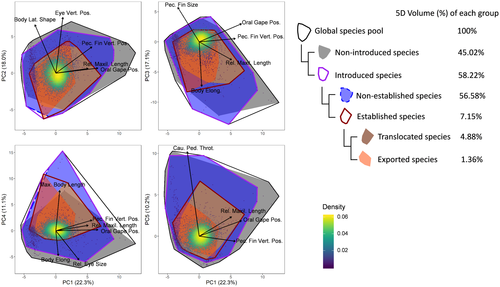
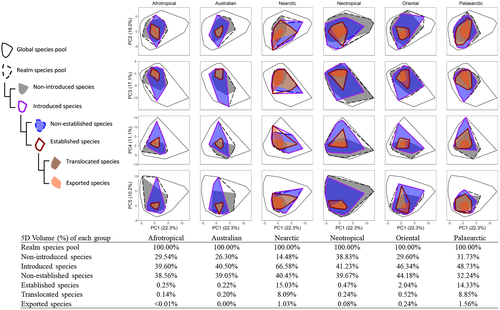
At the world scale, groups of species had distinct distributions in the 5D morphospace (Figure 2), as testified by significant differences (PERMANOVA and PERMDISP2 tests) between all pairs of species groups, except for the translocated and exported species in the PERMDISP2 test (Table 1). At the realm scale, the non-introduced species were still significantly different from all the other groups belonging to the introduced species in all the six realms (Table 1). Examining those patterns for each axis confirmed this trend, with the exception of the Australian realm on PC1 and PC3, and of the Nearctic realm on PC5 (Supporting Information Figure S3).
| Afrotropical | Australian | Nearctic | Neotropical | Oriental | Palaearctic | World | |
|---|---|---|---|---|---|---|---|
| Non-introduced versus introduced | < .001; < .001 | < .001; < .001 | < .001; < .001 | < .001; < .001 | < .001; < .001 | < .001; < .001 | < .001; < .001 |
| Non-introduced versus non-established | < .001; < .001 | < .001; < .001 | < .001; < .001 | < .001; < .001 | < .001; < .001 | < .001; < .001 | < .001; < .001 |
| Non-introduced versus established | < .001; < .001 | < .001; < .001 | < .001; < .001 | < .001; < .001 | < .001; < .001 | < .001; < .001 | < .001; < .001 |
| Non-established versus established | .022; .241 | .724; .860 | .915; .145 | .038; .176 | .014; .052 | .189; .109 | < .001; < .001 |
| Non-introduced versus translocated | < .001; < .001 | .004; < .001 | < .001; < .001 | < .001; < .001 | < .001; < .001 | < .001; < .001 | < .001; < .001 |
| Non-introduced versus exported | < .001; .014 | .048; NA | < .001; < .001 | < .001; < .001 | < .001; .002 | < .001; < .001 | < .001; < .001 |
| Translocated versus exported | .651; .735 | .108; NA | < .001; < .001 | .778; .403 | .292; .179 | .208;.884 | .031; .334 |
- Results are given for freshwater fish species from each realm and for the world fish fauna. See text for explanations about fish groups.
Comparing the non-established and established species showed significant differences in the Afrotropical (p = .022), Neotropical (p = .038) and Oriental (p = .014) realms (PERMANOVA test, Table 1). Examining PC axes one-by-one showed that established species significantly differed from the non-established species on PC3 and PC4 in both the Afrotropical and Oriental realms. These two groups of species differed significantly on PC2 and PC4 in the Neotropical realm (Figure 4). Moreover, although PERMANOVA and PERMDISP2 tests did not detect significant differences in variance of position in the morphospace between established and non-established species from the Nearctic realm (Figure 4), the K-S tests did detect significant differences in the distribution of values along PC3, PC4, and PC5 axes. In all the realms where the established species differed significantly from the non-established ones, the established species had higher values on the fourth dimension of the morphological space (PC4) than the non-established species, indicating larger and less elongated bodies (Figure 4). The established species showed the largest differences in values from the non-introduced species in all the significant comparisons, with the exception of Neotropical species on PC2 (Figure 4).
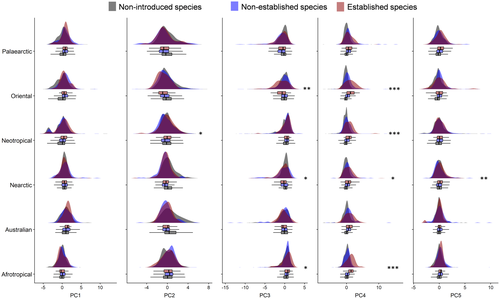
Although an overall examination of translocated versus exported species revealed a significant difference only in the Nearctic realm (PERMANOVA and PERMDISP2 tests, Table 1), an axis-by-axis examination reveals significant morphological differences on at least one out of the five PC axes in the five considered realms (the Australian realm was not considered as it has a single exported species). Generally, 9 out of the 25 comparisons between exported and translocated species in the 5 realms differed significantly. In Afrotropical and Nearctic realms, exported species were significantly different from the translocated species on PC3, PC4 and PC5. They also differed on PC3 in the Neotropical realm, on PC1 in the Oriental realm and on PC4 in the Palaearctic realm (Figure 5). In all the realms where the exported species differed significantly from the translocated ones, the exported species had larger and less elongated bodies (PC4) and higher caudal peduncle throttling values (PC5) than the translocated species (Figure 5). The exported species showed the largest difference in values from the non-introduced species in all the significant comparisons (Figure 5).
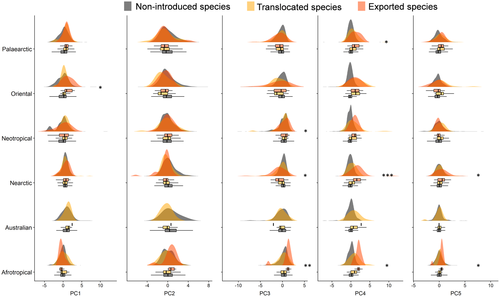
4 DISCUSSION
Across the globe, less than 20% of the known freshwater fish fauna has been used for various human purposes including fisheries, aquaculture, angling and as ornaments (Froese & Pauly, 2018). Assuming that these species of interest for humans have at least once been introduced in a river basin where they do not naturally occur appears realistic for two main reasons. First, 71.5% of the established species listed by Tedesco et al. (2017) belong to this category; and second, current records of introduction attempts, although regional and/or incomplete, report that introduced species are those having an interest for humans (Lintermans, 2004; Welcomme, 1988). The species of interest for humans here considered as introduced species have particular morphological traits distinguishing them from the non-introduced species. Moreover, the morphological space occupied by introduced species is greater than the space occupied by non-introduced species, although they account for less than a third of the number of the non-introduced species (2,272 vs. 6,460 species). Humans have therefore selected fish species with various morphological characteristics, despite a high functional redundancy of native species (Su et al., 2019). Such extended morphological selection of introduced species is consistent in all the six realms, and reflects distinct introduction purposes. The selection of large-bodied predators is associated with angling purposes, whereas laterally flattened species account for species inhabiting slow-flowing habitats that are often tolerant toward water quality and oxygen content and therefore easy to rear in aquaculture ponds (Blake, 1983; Haas, Blum, & Heins, 2010). In contrast, the selection of extreme morphologies is common in the ornamental trade (Howeth et al., 2016; Moyle & Marchetti, 2006). Compared to introduced species, established species occupy a lower volume of the world’s morphospace (less than 8%), indicating that the species that have established at least in one river basin where they do not historically occur have homogeneous and similar morphologies. Established species consistently have larger and more laterally compressed bodies than the non-established species in the six realms. This pattern reflects a marked environmental filtering effect at the establishment stage, which reinforces the introduction trend toward species with larger body sizes and more lateral compressed bodies. Fishes with laterally compressed bodies have high manoeuvrability and perform sustained swimming more efficiently in slow-flowing habitats (Blake, 1983; Haas et al., 2010). Thus, the global rise of river fragmentation and dam construction, which are known to facilitate the establishment of introduced species (Havel, Lee, & Vander Zanden, 2005; Johnson, Olden, & Vander Zanden, 2008) throughout the world (Anderson et al., 2018; Winemiller et al., 2016; Zarfl, Lumsdon, Berlekamp, Tydecks, & Tockner, 2015), can partly explain the pattern of morphological trait distributions of the established species. In addition, it should be noted that established species from industrialized realms (Palaearctic and Nearctic) have more diverse morphologies than those from the other realms (14 to 16% of the realm morphological space for Palaearctic and Nearctic realms versus less than 3% for the four other realms). This can be ascribed to a higher number of introduction events per species (i.e. propagule pressure), which is known to notably increase establishment probability (Lockwood, Cassey, & Blackburn, 2005). Among established species, the morphological differences between the translocated and the exported species were due to both differences in the species selected by humans to be introduced, and to different strengths of environmental filters, favouring the establishment of the most extreme morphologies in exported species. Indeed, most of the exported freshwater fish species result from the establishment of species intentionally introduced in one or several realms where the species do not naturally occur, whereas translocated species result from the establishment of species introduced intentionally or not. Hence, within a realm, short distance transport to nearby basins is easy and largely used by anglers to illegally spread some species of interest, but also to spread other accompanying species, such as baits. For instance, the introduction and spread of wels catfish (Silurus glanis) from eastern to western European rivers have largely been assisted by anglers (Cucherousset et al., 2018). Such short distance transport has also been recorded in the Neotropics for a series of harvested species including siluriforms (Pseudoplatystoma sp.), characiforms (Curimata sp.) and osteoglossiforms (Arapaima gigas) (Bezerra et al., 2019; Vitule et al., 2019). In contrast, exportations are more difficult, as fish must be kept alive across long distances, and therefore there is careful selection of the species to be introduced, often for commercial reasons. This discrepancy between translocation and exportation processes explains the morphological difference between the translocated and exported species, the latter being the largest and the most laterally flattened species, traits often preferred for aquaculture species. Interestingly, this trend was true for Palaearctic, Nearctic and Afrotropical species, but not for Neotropical fishes, probably because Neotropical fish account for most of the ornamental fish species, some establishing as exported species. It is, for instance, the case for the guppy, Poecilia reticulata, which originates from the Neotropical realm, but established in all realms following its introduction as an ornamental fish (Deacon, Ramnarine, & Magurran, 2011). Those ornamental fish have various morphologies, but are often small sized, counterbalancing therefore the trend toward the large body sized exported fishes found in the other realms. The distinct pattern between exported and translocated species observed across realms testifies for distinct human selection modes of exported and translocated species, but can also reflect distinct establishment processes between the realms, paralleling the results of Blanchet et al. (2010) demonstrating discrepancies in establishment determinants between realms. Indeed, within a realm, a translocated species will encounter similar environments to its native range and will share its new habitat with species shaped by the same regional evolutionary constraints (Colautti, Eckert, & Barrett, 2010). In contrast, an exported species has to face a fauna that evolved under a distinct regional history (Nekola & White, 1999).
To conclude, fish morphological traits are closely related to the introduction and establishment stages of the invasive process. Human selection affects the introduction stage, and selects a subset of a realm’s fish morphology, with a preference towards large pelagic predators with high dispersal ability. However, environmental filtering profoundly reshapes the morphology of established species. The c. 400 introduced species that established (out of c. 2,700 introduced species) are the most laterally flattened, and inhabit slow-flowing habitats (e.g. lakes, reservoirs), therefore reinforcing that morphological selection achieved by humans at the introduction stage. Nevertheless, the recent development of the ornamental fish trade associated with the global rise of leisure activities might lead to a considerable change in human interest for particular morphological traits. Those traits will be markedly different from the traits of interest for aquaculture or angling species. That will probably lead, as initiated in the Neotropics, to the introduction of an extended range of morphologies, and will increase the pool of introduced species in the future. In the same way, the economic development of tropical countries (e.g. China in the Oriental realm and Brazil in the Neotropical realm) makes them providers of new non-native species through local aquaculture, aquarium and angling development (Vitule et al., 2009, 2019; Vitule, Skóra, & Abilhoa, 2012). This trend might thus increase in the near future the diversity of established species in the tropical realms. Among those new pools of introduced species, some might establish in the recipient environments and cause profound functional changes to the recipient communities (Capps & Flecker, 2013). Given that once established, eradicating an introduced species is often impossible, we call for particular caution against non-native species introductions (Vitule et al., 2009).
ACKNOWLEDGMENTS
SG was funded by the China Scholarship Council. The EDB laboratory was supported by ‘Investissement d’Avenir’ grants (CEBA, ANR-10-LABX-0025; TULIP, ANR-10-LABX-41). We are grateful to Aurèle Toussaint and Nicolas Charpin for help in data acquisition.
Open Research
DATA AVAILABILITY STATEMENT
Fish occurrence data can be freely retrieved at https://doi.org/10.6084/m9.figshare.c.3739145 and metadata are available in Tedesco et al. (2017). Fish maximum body lengths were downloaded from FishBase (http://www.fishbase.org). Information about the 9,150 species with combined trait values (PC1–PC5) used in this study are available in Su et al. (2019).
REFERENCES
BIOSKETCHES
Guohuan Su is a PhD student in the laboratory ‘Evolution et Diversité Biologique’ (University of Toulouse, France). He is interested in the macroecology and diversity of freshwater fish. He is currently investigating the morphological differences between non-native and native species in the freshwater fish fauna and the influence of global changes on global morphological and phylogenetic patterns.
Sébastien Villéger is a researcher at the Centre national de la recherche scientifique in Montpellier. He is interested in functional ecology of fishes and is particularly studying the effects of global change on the functional diversity of fish assemblages.
Sébastien Brosse is a professor of Ecology at the University of Toulouse. He is interested in freshwater fish biodiversity patterns and processes across the globe, and in the influence of global changes on fish distribution at both macroecological and local scales.



